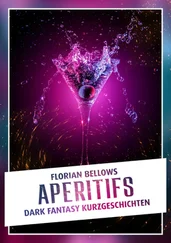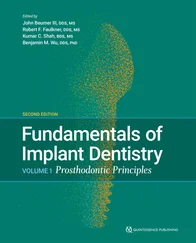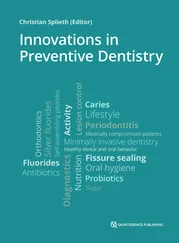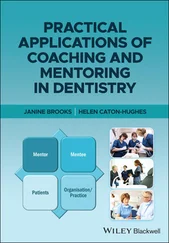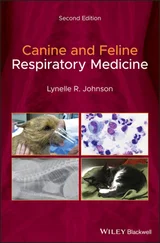1 Cover
2 Title Page Feline Dentistry Second Edition Jan Bellows All Pets Dental Weston, Florida, USA
3 Copyright Page
4 Dedication
5 About the Author
6 Forewords
7 Acknowledgments
8 Introduction
9 1 Anatomy 1.1 Oral Cavity 1.2 Mucosa 1.3 Muscles 1.4 Tongue 1.5 Innervation 1.6 Blood Supply and Lymphatic Drainage 1.7 Salivary Glands 1.8 Periodontium 1.9 Gingiva 1.10 Periodontal Ligament 1.11 Cementum 1.12 Alveolar Bone 1.13 Bones and Joints 1.14 Maxillary Region 1.15 Mandibles 1.16 Temporomandibular Joint 1.17 Teeth 1.18 Variation in Tooth Number and Morphology 1.19 Composition 1.20 Tooth Eruption Further Reading
10 2 The Feline Dental Operatory – Equipment, Instruments, and Materials 2.1 Space 2.2 Electricity, Water, and Drainage 2.3 Ergonomics 2.4 The Operatory 2.5 Adjustable Stools/Chairs 2.6 Built‐in Desk 2.7 Powered Dental Delivery Systems 2.8 Storage 2.9 Lighting 2.10 Dental Loupes (Telescopes) 2.11 Radiography 2.12 General Anesthesia 2.13 Patient Monitoring Devices 2.14 Dental Charts 2.15 Dental Explorer 2.16 Periodontal Probe 2.17 Operator Safety Equipment 2.18 Dental Scaling, Irrigation and Polishing Equipment, Instruments, and Techniques 2.19 Extraction Instruments and Materials 2.20 Dental Handpieces 2.21 Maintenance of Dental Equipment 2.22 Homecare Products to Reduce the Accumulation of Plaque and Tartar (Calculus) 2.23 Equipment and Materials for Advanced Dental Care 2.24 Obturating the Canal 2.25  ADVANCED PROCEDURES 2.26 Lasers Further Reading
ADVANCED PROCEDURES 2.26 Lasers Further Reading
11 3 Anesthesia and Analgesia for Feline Dental Patients 3.1 Non‐Professional Dental Scaling (NPDS) 3.2 Preanesthetic Evaluation 3.3 Anesthesia Protocols 3.4 Premedication 3.5 Medical Conditions Requiring Tailored Protocols 3.6 Feline Hypertrophic Cardiomyopathy 3.7 Maintenance 3.8 Monitoring 3.9 Blood Pressure (BP) 3.10 End‐Tidal Carbon Dioxide (ETCO 2) 3.11 Pulse Oximetry (SpO 2) 3.12 Electrocardiography (EKG) 3.13 Maxillae 3.14 Mandibles 3.15 Constant Rate Infusion (CRI) 3.16 Transdermal Pain Patch 3.17 Opioids and Hyperthermia 3.18 Postoperative Analgesia 3.19 Meloxicam 3.20 Decreasing Fear, Anxiety, and Stress 3.21 Music 3.22 Feline Facial Pheromones 3.23 In the Reception Area and Examination Room 3.24 Feline Orofacial Pain Syndrome (FOPS) Further Reading
12 4 The Oral Disease Prevention, Assessment, and Prevention Visit 4.1 The Oral Disease Prevention, Assessment, and Prevention Visit 4.3 Treatment 4.4 Case Volume 4.5 Workflow 4.6 Workflow Example 4.7 Workflow Timeline 4.8 Two‐/Four‐Handed Charting 4.9 Step‐By‐Step Charting 4.10 Periodontal Indices 4.11 Diagnostic Hand Instruments Used to Aid Charting 4.12 Dental Explorer 4.13 Furcation Disease 4.14 Bleeding on Probing 4.15 Gingivitis Index 4.16 Tooth Mobility 4.17 Crown Pathology Further Reading
13 5 Dental Radiography 5.1 Workflow – Incorporating Dental Radiography into General Practice 5.2 Radiation Safety 5.3 Radiograph Image Troubleshooting 5.4 Positioning 5.5 Radiograph Interpretation 5.6 Radiographic Interpretation of Periodontal Disease 5.7 Endodontic Disease 5.8 External Root Resorption Further Reading
14 6 Tooth Resorption 6.1 Prevalence 6.2 Terminology 6.3 Etiology 6.4 Clinical Signs 6.5 Classification 6.6 Clinical Examination Findings 6.7 Pathogenesis 6.8 Histology 6.9 Treatment of Tooth Resorption 6.10 Monitoring Without Immediate Care 6.11 Crown/Root Atomization 6.12 Tooth Extraction 6.13 Crown Amputation with Intentional Partial Root Retention Followed by Gingival Closure 6.14 Crown Amputation with Intentional Root Retention and Gingival Closure (Crown Removal with Retention of Resorbing Root Tissue) Further Reading
15 7 Oropharyngeal Inflammation 7.1 Gingival and Periodontal Diseases 7.2 Clinical Approach to Periodontal Disease 7.3 Treatment of Minimal Gingival Recession 7.4 Technique for Placing a Bone Graft into a Palatal Defect 7.5 Scheduling the Next Oral Disease Assessment Treatment and Prevention Visit 7.6 Efficacy of Homecare Products Purported to Decrease the Accumulation of Plaque and Tartar 7.7 Cotton Swabbed Applicators Rubbed Along the Gingival Margin 7.8 Dental Treats 7.9 Anti‐Inflammatory Medication 7.10 Protocols for Intralesional Use of Interferon Further Reading
16 8 Oral Masses 8.1 Visual Examination Findings 8.2 Benign Neoplasia 8.3 Oral Malignancy 8.4 Surgical Options to Treat Oral Swellings 8.5 General Principles Further Reading
17 9 Oral Cavity Trauma 9.3 Dental Trauma Location 9.4 Endodontic Therapy 9.5 The International Standards Organization (ISO) 9.6 Fundamental Endodontic Procedures 9.7 Standard (Conventional) Root Canal Therapy 9.8 Mandibular Symphysis Separation 9.9 Mandibular Fractures 9.10 Temporomandibular Joint Ankylosis 9.11 Open‐Mouth Jaw Locking Further Reading
18 10 Occlusal Disorders 10.1 Normal Occlusion in the Mesaticephalic Cat 10.2 Malocclusion 10.3 Angle Classification 10.4 Skeletal Malocclusions 10.5 Dental Malocclusion 10.6 Treatment of Occlusal Disorders 10.7 Moving Teeth into Functional Positions 10.8 Orthodontic Buttons and Elastics 10.9 Specific Occlusal Disorders Further Reading
19 Index
20 End User License Agreement
1 Chapter 1 Table 1.1 Approximate age by which permanent teeth erupt (in days).
2 Chapter 2 Table 2.1 Five ergonomic classes and movement.
3 Chapter 3Table 3.1 Medications used for preanesthesia, induction, and anesthesia.Table 3.2 Sample anesthesia protocols based on age and weight.Table 3.3 Sample anesthesia monitoring form.Table 3.4 Analgesic medications.
4 Chapter 4Table 4.1 Abbreviations.Table 4.2 Furcation involvement and exposure.Table 4.3 Gingival index score.Table 4.4 Tooth mobility.Table 4.5 Plaque index.Table 4.6 Calculus index.Table 4.7 Common oral pathology.Table 4.8 Terms and abbreviations.Table 4.9 Terms and abbreviations for tooth resorption.
5 Chapter 5Table 5.1 Software study and image optionsTable 5.2 Positioning.
6 Chapter 7Table 7.1 Summary of periodontal therapy.Table 7.2 Scoring systems used for evaluation of feline chronic gingivitis ...Table 7.3 Modified Lommer stomatitis disease activity index.
7 Chapter 9Table 9.1 ISO standardization also uses a color for each size, as shown bel...
8 Chapter 10Table 10.1 Angle classification.
1 Chapter 1 Figure 1.1 (a) Maxilla. (b) Maxillae, mandibles and sublingual areas. (c) Ri... Figure 1.2 Tongue papillae. Figure 1.3 Caudal oral cavity. Figure 1.4 Sublingual caruncles. Illustration 1.1 Cat salivary glands. Figure 1.5 Membranous bulge linguodistal to the mandibular first molar tooth... Figure 1.6 Oral mucosa in a patient with gingivitis, periodontitis, and caud... Figure 1.7 (a) and (b) Gingival structures surrounding the left maxillary (a... Figure 1.8 Compressed air from an air/water syringe exposing the normal 0.5 ... Figure 1.9 (a) Sagittal section revealing the periodontal ligament location ... Figure 1.10 Lamina dura (arrows pointing to the white line surrounding the t... Figure 1.11 (a) Alveolus encasing a fractured maxillary canine tooth. (b) De... Figure 1.12 (a) Left lateral aspect of the skull with the zygomatic arch rem... Figure 1.13 (a) Lateral aspect of right maxilla: 1. Alveolar process; 2. Fro... Figure 1.14 (a) Palatine fissures. (b) Incisive papilla. Figure 1.15 (a) Lower jaw. (b) Right mandible buccal aspect: 1. Mandibular b... Figure 1.16 (a) Mandibular symphysis dorsal view. (b) Mandibular symphysis r... Figure 1.17 Temporomandibular joints ventral view: 1. Retroarticular process... Figure 1.18 Lateral aspect of the left temporomandibular joint: 1. Coronoid ... Figure 1.
Читать дальше
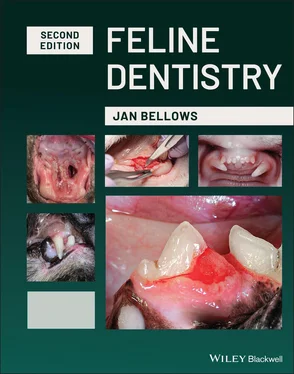
 ADVANCED PROCEDURES 2.26 Lasers Further Reading
ADVANCED PROCEDURES 2.26 Lasers Further Reading

